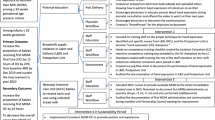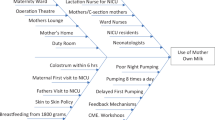Abstract
Objective
Evaluate a single center quality improvement (QI) collaborative designed to increase the provision of mother’s own milk (MOM) at discharge to premature infants through evidence-based practices while targeting perinatal health disparities.
Design
This QI initiative was designed for preterm infants admitted to a single-center NICU within 24 h of life. Interventions were implemented between March 2022 and June 2022. MOM provision rates were compared between baseline (August 2021–February 2022), and after interventions (March 2022–December 2022).
Results
The percentage of mothers who discontinued pumping during the infant hospitalization decreased from 49% to 35% (p < 0.01). Infant discharge diet with MOM improved from 36% to 58% (p < 0.001). Pump frequency at two weeks increased from 4.0 ± 2.6 to 5.1 ± 2.4 (p = 0.026).
Conclusion
Our collaborative increased the percentage of preterm infants receiving MOM at discharge and reduced the number of mothers who discontinue pumping during the NICU hospitalization.
This is a preview of subscription content, access via your institution
Access options
Subscribe to this journal
Receive 12 print issues and online access
$259.00 per year
only $21.58 per issue
Buy this article
- Purchase on Springer Link
- Instant access to full article PDF
Prices may be subject to local taxes which are calculated during checkout


Similar content being viewed by others
Data availability
The dataset generated and analyzed during the study are available from the corresponding author on reasonable request.
References
Chetta KE, Schulz EV, Wagner CL. Outcomes improved with human milk intake in preterm and full-term infants. Semin Perinatol. 2021;45:151384.
Patel AL, Johnson TJ, Engstrom JL, Fogg LF, Jegier BJ, Bigger HR, et al. Impact of early human milk on sepsis and health-care costs in very low birth weight infants. J Perinatol. 2013;33:514–9.
Patel AL, Johnson TJ, Robin B, Bigger HR, Buchanan A, Christian E, et al. Influence of own mother’s milk on bronchopulmonary dysplasia and costs. Arch Dis Child - Fetal Neonatal Ed. 2017;102:F256–F61.
Vohr BR, Poindexter BB, Dusick AM, McKinley LT, Higgins RD, Langer JC, et al. Persistent beneficial effects of breast milk ingested in the neonatal intensive care unit on outcomes of extremely low birth weight infants at 30 months of age. Pediatrics. 2007;120:e953–9.
Meier PP. Human milk and clinical outcomes in preterm infants. Nestle Nutr Inst Workshop Ser. 2019;90:163–74.
Sisk PM, Lovelady CA, Dillard RG, Gruber KJ, O’Shea TM. Early human milk feeding is associated with a lower risk of necrotizing enterocolitis in very low birth weight infants. J Perinatol. 2007;27:428–33.
Corpeleijn WE, Kouwenhoven SM, Paap MC, van Vliet I, Scheerder I, Muizer Y, et al. Intake of own mother’s milk during the first days of life is associated with decreased morbidity and mortality in very low birth weight infants during the first 60 days of life. Neonatology. 2012;102:276–81.
Romaine A, Clark RH, Davis BR, Hendershot K, Kite V, Laughon M, et al. Predictors of prolonged breast milk provision to very low birth weight infants. J Pediatr. 2018;202:23–30.e1.
Ryan AS, Wenjun Z, Acosta A. Breastfeeding continues to increase into the new millennium. Pediatrics. 2002;110:1103–9.
Parker MG, Greenberg LT, Edwards EM, Ehret D, Belfort MB, Horbar JD. National trends in the provision of human milk at hospital discharge among very low-birth-weight infants. JAMA Pediatr. 2019;173:961–8.
Sisk PM, Lovelady CA, Dillard RG, Gruber KJ. Lactation counseling for mothers of very low birth weight infants: effect on maternal anxiety and infant intake of human milk. Pediatrics. 2006;117:e67–e75.
ABM Clinical Protocol #35: supporting breastfeeding during maternal or child hospitalization. Breastfeeding Med. 2021;16:664–74.
2022 March of Dimes Report Card [Internet]. 2022 [Available from: https://www.marchofdimes.org/report-card.]
Hoban R, Bigger H, Schoeny M, Engstrom J, Meier P, Patel AL. Milk volume at 2 weeks predicts mother’s own milk feeding at neonatal intensive care unit discharge for very low birthweight infants. Breastfeed Med. 2018;13:135–41.
Meier PP, Engstrom JL, Janes JE, Jegier BJ, Loera F. Breast pump suction patterns that mimic the human infant during breastfeeding: greater milk output in less time spent pumping for breast pump-dependent mothers with premature infants. J Perinatol. 2012;32:103–10.
Parker LA, Sullivan S, Krueger C, Kelechi T, Mueller M. Effect of early breast milk expression on milk volume and timing of lactogenesis stage II among mothers of very low birth weight infants: a pilot study. J Perinatol. 2012;32:205–9.
Parker LA, Sullivan S, Kruger C, Mueller M. Timing of milk expression following delivery in mothers delivering preterm very low birth weight infants: a randomized trial. J Perinatol. 2020;40:1236–45.
Parker MG, Stellwagen LM, Noble L, Kim JH, Poindexter BB, Puopolo KM, et al. Promoting human milk and breastfeeding for the very low birth weight infant. Pediatrics. 2021;148:e2021054272.
Ohyama M, Watabe H, Hayasaka Y. Manual expression and electric breast pumping in the first 48 h after delivery. Pediatr Int. 2010;52:39–43.
Lussier MM, Brownell EA, Proulx TA, Bielecki DM, Marinelli KA, Bellini SL, et al. Daily breastmilk volume in mothers of very low birth weight neonates: a repeated-measures randomized trial of hand expression versus electric breast pump expression. Breastfeed Med. 2015;10:312–7.
Meier PP, Engstrom JL, Hurst NM, Ackerman B, Allen M, Motykowski JE, et al. A comparison of the efficiency, efficacy, comfort, and convenience of two hospital-grade electric breast pumps for mothers of very low birthweight infants. Breastfeed Med. 2008;3:141–50.
Harris PA, Taylor R, Minor BL, Elliott V, Fernandez M, O’Neal L, et al. The REDCap consortium: Building an international community of software platform partners. J Biomed Inform. 2019;95:103208.
Harris PA, Taylor R, Thielke R, Payne J, Gonzalez N, Conde JG. Research electronic data capture (REDCap)—a metadata-driven methodology and workflow process for providing translational research informatics support. J Biomed Inform. 2009;42:377–81.
Montgomery DC. Introduction to statistical quality control (Wiley, 2020).
Wheeler TA, Davis JT, Brilli RJ. The aggregate point rule for identifying shifts on P charts and U charts. Pediatr Qual Saf. 2018;3:e103.
Ogrinc G, Davies L, Goodman D, Batalden P, Davidoff F, Stevens D. SQUIRE 2.0 (<em>Standards for QUality Improvement Reporting Excellence)</em>: revised publication guidelines from a detailed consensus process. BMJ Qual Saf. 2016;25:986–92.
Lee HC, Martin-Anderson S, Lyndon A, Dudley RA. Perspectives on promoting breastmilk feedings for premature infants during a quality improvement project. Breastfeed Med. 2013;8:176–80.
Porta R, Miralles N, Paltrinieri A, Ibáñez B, Giménez J, Roca T, et al. A breast milk pump at the bedside: a project to increase milk production in mothers of very low birth weight infants. Breastfeed Med. 2021;16:309–12.
Gertz B, DeFranco E. Predictors of breastfeeding non-initiation in the NICU. Matern Child Nutr. 2019;15:e12797.
Lu MC, Lange L, Slusser W, Hamilton J, Halfon N. Provider encouragement of breast-feeding: evidence from a national survey. Obstet Gynecol. 2001;97:290–5.
Parker MG, Burnham LA, Melvin P, Singh R, Lopera AM, Belfort MB, et al. Addressing disparities in mother’s milk for VLBW infants through statewide quality improvement. Pediatrics. 2019;144:e20183809.
Lee HC, Kurtin PS, Wight NE, Chance K, Cucinotta-Fobes T, Hanson-Timpson TA, et al. A quality improvement project to increase breast milk use in very low birth weight infants. Pediatrics. 2012;130:e1679–87.
Bixby C, Baker-Fox C, Deming C, Dhar V, Steele C. A multidisciplinary quality improvement approach increases breastmilk availability at discharge from the neonatal intensive care unit for the very-low-birth-weight infant. Breastfeed Med. 2016;11:75–9.
Meier PP, Patel AL, Bigger HR, Rossman B, Engstrom JL. Supporting breastfeeding in the neonatal intensive care unit: rush Mother’s Milk Club as a case study of evidence-based care. Pediatr Clin North Am. 2013;60:209–26.
Spatz DL, Froh EB, Schwarz J, Houng K, Brewster I, Myers C, et al. Pump early, pump often: a continuous quality improvement project. J Perinat Educ. 2015;24:160–70.
Alshaikh B, Kostecky L, Blachly N, Yee W. Effect of a quality improvement project to use exclusive mother’s own milk on rate of necrotizing enterocolitis in preterm infants. Breastfeed Med. 2015;10:355–61.
The Surgeon General’s “Blueprint for Action on Breastfeeding”. J Perinat Educ. 2001;10:45–7.
Centers for Disease Control and Prevention. Breastfeeding report card—United States, 2022, 2022 [Available from: www.cdc.gov/breastfeeding/data/reportcard.htm.]
Acknowledgements
The authors would like to acknowledge MUSC IBCLCs (Jeanne Barreira, Sarah Brunson, Miranda Conrad, Margaret Fontaine, Ellen Linder, Amy Pizzuti Brown, and Dorothy Winters) for their dedication to high-quality lactation support; Other members of the Low Country Milk Club (Erika Drexler, RN, Lisa Kidd, RN, and Dr. Alexandra Rowin); Christy Shelton whose insight in providing MOM for her son in the NICU was invaluable; MUSC interpreting services and April Martinez, NNP for assistance translating materials to Spanish; Sallyanne Koontz for coordinating media outreach and publications; Lowcountry WIC staff (Kristin Pillion, Caroline Madsen, Courtney Smith, and Nancy Kate Pippin Suchecki); and Dr. John Baatz for critically reviewing this manuscript.
Funding
This project was funded in part by the David and Laura Stone Endowment for Advancement in Neonatal Medicine, Division of Neonatology, Medical University of South Carolina (MUSC) (NSB, KEC). Additional funding sources provided by the Clinical Component Core of the MUSC Digestive Disease Research Core Center (P30 DK123704) (KEC), COBRE Digestive Liver Disease Center (KEC), and the National Center for Advancing Translational Sciences of the National Institutes of Health under Award Numbers KL2TR001452 (KEC) and UL1TR001450 (MJG). The content is solely the responsibility of the authors and does not necessarily represent the official views of the National Institutes of Health.
Author information
Authors and Affiliations
Contributions
NSB, KEC: conceptualized manuscript. NSB: original draft preparation. NSB, BLB, AR, KEC, MJG: collected data. KEC, MJG, NSB, CLW: data analysis. All authors reviewed, edited, and approved the final manuscript. Funding is provided by KEC, MJG, and NSB. KEC, KGL, AR: supervised quality interventions, data collection, and data analysis.
Corresponding author
Ethics declarations
Competing interests
All physical materials are copyrighted MUSC 2022© and are original material crafted for this QI effort. The authors have no financial interest to declare in relation to the content of this article.
Additional information
Publisher’s note Springer Nature remains neutral with regard to jurisdictional claims in published maps and institutional affiliations.
Supplementary information
Rights and permissions
Springer Nature or its licensor (e.g. a society or other partner) holds exclusive rights to this article under a publishing agreement with the author(s) or other rightsholder(s); author self-archiving of the accepted manuscript version of this article is solely governed by the terms of such publishing agreement and applicable law.
About this article
Cite this article
Boone, N., Bohara, B., Rohrer, A. et al. Multi-prong quality improvement approach for increasing mother’s own milk use for very low birth weight infants. J Perinatol (2023). https://doi.org/10.1038/s41372-023-01835-w
Received:
Revised:
Accepted:
Published:
DOI: https://doi.org/10.1038/s41372-023-01835-w



